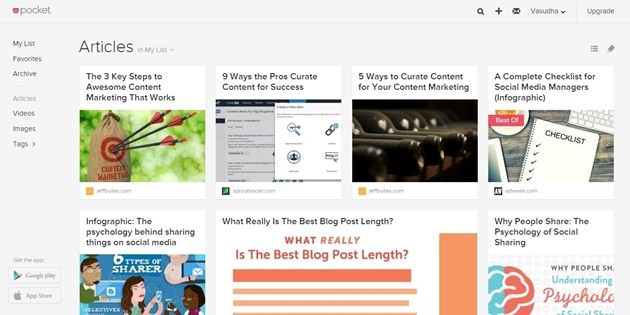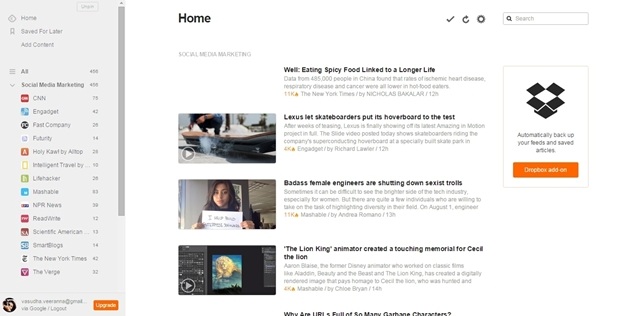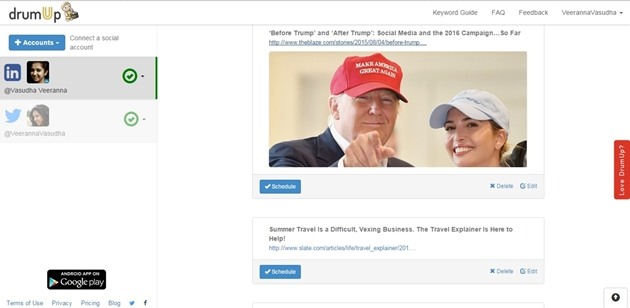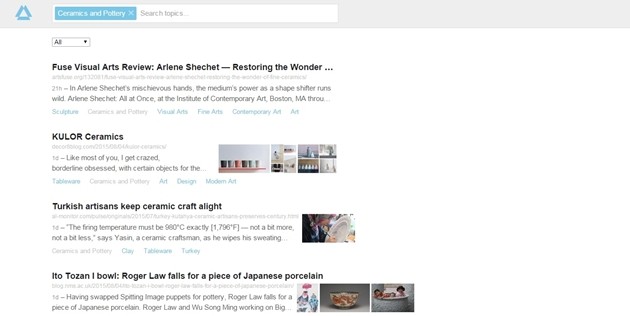Two popular content-curation tools shut down earlier this year: Buffer announced it would be closing its content suggestions feature, and Swayy was acquired by SimilarWeb, which led to the tool's shuttering.
Sharing great content, particularly via social media, can seem like an uphill task without tools like Buffer and Swayy, so here are six other tools you can use to keep your social media pages buzzing with great content.
Pocket is a smart-bookmarking service that lets you save articles, videos, and images for later use. The tool also comes with a useful browser extension; once you install it, each time you come across a video, an article, or image you'd like to use, all you have to do is click on the Pocket icon on your taskbar to save an item.
The tool is particularly useful to content marketers and social media managers who end up spending a significant amount of time online, but don't always have the time to read an interesting article as soon as they find it. It also lets you archive or delete saved items.
Pocket makes it easy to organize content with the use of tags. If you're going to be using Pocket, it's a good idea to add tags to each item when you read/view it. Doing so makes it more accessible should you want to revisit it in future.
Items saved to Pocket can be shared individually on Twitter and Facebook.
Flipboard is a content-aggregation tool that offers localized content in 20+ languages. The tool aggregates content from several sources, including social media. It not only gives you access to a wide variety of topics but also presents all that content in a pleasing, easy-to-use magazine format.
The tool aggregates content in all formats, including text, images, videos, and podcasts.
When setting up an account, you will be required to follow a minimum of five topics out of the thousands of topics available. You can add more topics to follow later by clicking on the Search icon and typing in the topic you're looking for. Considering the variety of sources and topics on the tool, it's unlikely for it to not return any results for a particular subject.
Flipboard lets you share the content you discover on Facebook and Twitter. You can also organize content into magazines, and follow other people on Flipboard to access their curated collections of content.
Feedly is a free RSS reader that originally gained popularity as an alternative to Google Reader. However, over the years, it has become a go-to source for content marketers, thanks to the quality of its sources and recommendations.
The tool has been built with a minimalist design and interface, making it user-friendly. It lets you track people and businesses within your industry, follow specific blogs and bloggers, organize your RSS feeds, and share the content you discover on Twitter and Facebook.
To set up an account on Feedly, you will require a Gmail account. However, once registered, you can log in using Facebook, Google, Twitter, Evernote, or Windows authentication.
DrumUp is an intelligent content discovery, curation, and social media scheduling tool. It uses machine learning and Natural Language Processing algorithms to sieve through thousands of Web pages and recommend fresh and relevant content for your social media accounts.
You can connect any number of social accounts to a single dashboard. The content suggestions on DrumUp are refreshed every day based on the keywords you set for a particular social account. Since the tool lets you specify a separate set of keywords for each account, it becomes easier to avoid cross-posting.
DrumUp is integrated with Facebook, Twitter, and LinkedIn. Apart from scheduling content to be posted on those platforms, the tool lets you add custom posts, along with images. You can also connect your blog feed to ensure that your posts get shared on social media as they're published.
(Disclosure: I write for the DrumUp blog.)
Prismatic is basically a content discovery app, but it doubles as networking site. Users on Prismatic have access to a vast amount of content that is aggregated from thousands of sources on the Web, and they can comment on the articles within the app itself, without having to navigate to the original source.
Content recommendations on Prismatic come with a time stamp to indicate their freshness. For content curators who are constantly on the lookout for relevant and engaging content, Prismatic is a great tool to use since its recommendations include stories from sources that may be less popular but are nevertheless good.
The tool uses machine learning algorithms that understand your content preferences based on your social media activity; your social accounts (Facebook, Twitter) have to be connected to the tool for it to refine your search results based on what you and your connections are sharing.
Scoop.it lets you find and share content based on a keyword search. You can review the content recommendations and Scoop the ones you like to create your very own content bucket. Once you create a Scoop, use the Suggested Content tab to add more content to it. You can also upload your own documents to Scoop.it.
The tool offers both sharing and scheduling options for social media management. However, the latter is available only to paid users. If you're using a free account, you can share your Scoops only individually. Even with a free account, you can post on multiple social media platforms, including Twitter, Facebook, LinkedIn, and Google+.
The paid version of Scoop.it offers advanced features such as newsletter creation, content analytics, and integration with Marketo, Mail Chimp, Hootsuite, HubSpot, and Buffer.
* * *
If you've used any of these six tools, or any others that you think can come in handy in curating content for social media, do leave a comment in the section below.










